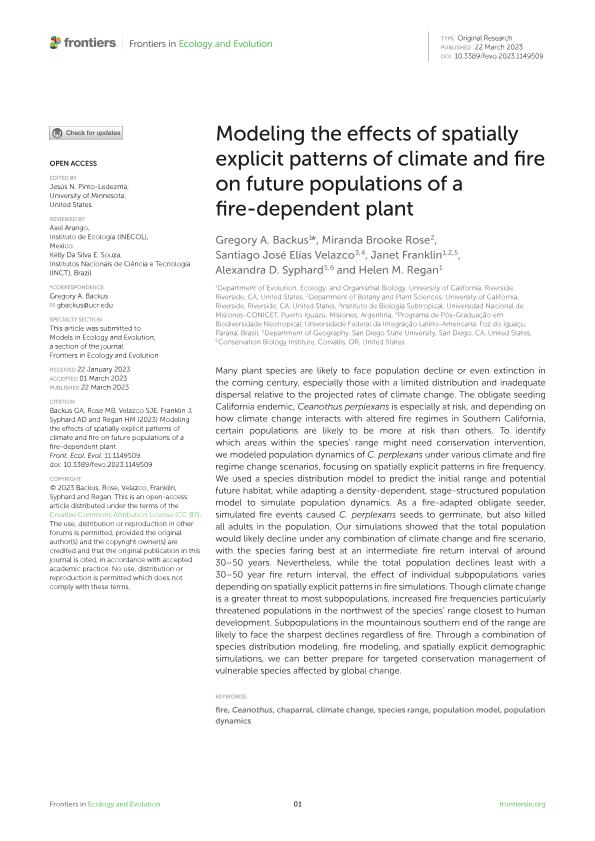Artículo
Modeling the effects of spatially explicit patterns of climate and fire on future populations of a fire-dependent plant
Backus, Gregory A.; Brooke Rose, Miranda; Velazco, Santiago José Elías ; Franklin, Janet; Syphard, Alexandra D.; Regan, Helen M.
; Franklin, Janet; Syphard, Alexandra D.; Regan, Helen M.
 ; Franklin, Janet; Syphard, Alexandra D.; Regan, Helen M.
; Franklin, Janet; Syphard, Alexandra D.; Regan, Helen M.
Fecha de publicación:
03/2023
Editorial:
Frontiers Media
Revista:
Frontiers in Ecology and Evolution
ISSN:
2296-701X
Idioma:
Inglés
Tipo de recurso:
Artículo publicado
Clasificación temática:
Resumen
Many plant species are likely to face population decline or even extinction in the coming century, especially those with a limited distribution and inadequate dispersal relative to the projected rates of climate change. The obligate seeding California endemic, Ceanothus perplexans is especially at risk, and depending on how climate change interacts with altered fire regimes in Southern California, certain populations are likely to be more at risk than others. To identify which areas within the species’ range might need conservation intervention, we modeled population dynamics of C. perplexans under various climate and fire regime change scenarios, focusing on spatially explicit patterns in fire frequency. We used a species distribution model to predict the initial range and potential future habitat, while adapting a density-dependent, stage-structured population model to simulate population dynamics. As a fire-adapted obligate seeder, simulated fire events caused C. perplexans seeds to germinate, but also killed all adults in the population. Our simulations showed that the total population would likely decline under any combination of climate change and fire scenario, with the species faring best at an intermediate fire return interval of around 30–50 years. Nevertheless, while the total population declines least with a 30–50 year fire return interval, the effect of individual subpopulations varies depending on spatially explicit patterns in fire simulations. Though climate change is a greater threat to most subpopulations, increased fire frequencies particularly threatened populations in the northwest of the species’ range closest to human development. Subpopulations in the mountainous southern end of the range are likely to face the sharpest declines regardless of fire. Through a combination of species distribution modeling, fire modeling, and spatially explicit demographic simulations, we can better prepare for targeted conservation management of vulnerable species affected by global change.
Archivos asociados
Licencia
Identificadores
Colecciones
Articulos(IBS)
Articulos de INSTITUTO DE BIOLOGIA SUBTROPICAL
Articulos de INSTITUTO DE BIOLOGIA SUBTROPICAL
Citación
Backus, Gregory A.; Brooke Rose, Miranda; Velazco, Santiago José Elías; Franklin, Janet; Syphard, Alexandra D.; et al.; Modeling the effects of spatially explicit patterns of climate and fire on future populations of a fire-dependent plant; Frontiers Media; Frontiers in Ecology and Evolution; 11; 3-2023; 1-12
Compartir
Altmétricas



